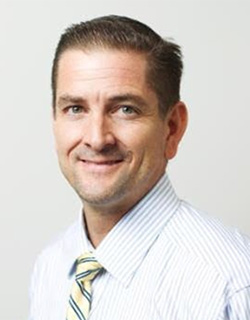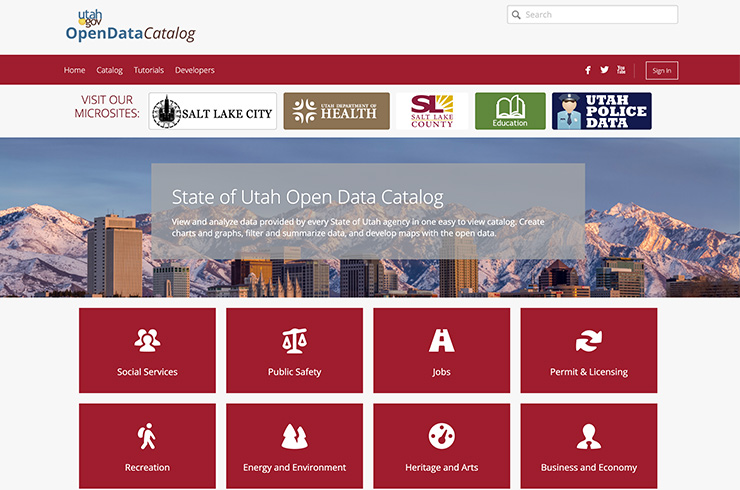Utah Chief Data Officer Makes Data More Powerful
June 17, 2019 by Melissa Crowe

As Utah's state data coordinator, Drew Mingl made it his mission to break down the imaginary lines drawn between agencies.
 Drew Mingl
Drew Mingl"On its own, a single dataset is powerful, but when you merge two of these powerful datasets together, you get something with an even bigger, more extraordinary impact," Mingl says.
Take education and unemployment. If you can match up those two datasets — as Mingl did in a role he held prior to becoming the state's data coordinator — you can gain insight into the earning power of degrees and majors.
When Mingl was appointed to the state-level role in 2014, he was given a straightforward mission.
"The Utah Transparency Advisory Board wanted a single website with all the state's publicly available open data in one spot," recalls Mingl. "People don't want to go to one site for information on crime data and another for housing prices."
Just 16 weeks after he came on board, he was able to launch the Socrata-powered State of Utah Open Data Catalog.
"I'm a huge fan of Socrata because the software is plug-and-play," says Mingl.
We spoke to Mingl about using data in the fight against homelessness, overcoming resistance to data sharing, and much more.

What does data governance mean to you?
In Utah, we have 25 executive agencies, each headed by a person appointed by the governor. It can be easy to view data as currency when you are in that role and you want people to visit agency websites. Overcoming this resistance is a big part of my job.
An effective CDO has to be a data wonk, know where to find the data, and have lawyer-like abilities. My conversations with data owners often start with a "no," because people tend to be risk-averse, but there's almost always a way to get to a "yes."
One of my strategies is to start off with a visit to the assistant attorney general assigned to a specific agency. At our meeting, we'll go over the legal parameters around sharing the data, whether it's FERPA, HIPAA, CJIS, etc. That makes my visit with the data steward go more smoothly once the Attorney General's Office agrees the data can be shared.
Currently, we can have as many of 45 different data-sharing agreements for one single agency. These agreements need to be reviewed and signed annually. Our goal is to distill them into four, possibly five agreements, and standardize the paperwork so we can expedite the data-sharing process.
How can government begin to address data quality?
That's a really deep question. That's one of the big concerns people have about me going in and viewing their data.
Here in Utah, each agency has the ability to store and manage their data as they see fit. At the Department of Technology Services, we're working to define and set up data standards that all agencies must follow. That's things like standardizing field names, address formats, etc.
Often, a single business will have unique identification numbers with each agency it interacts with — the Department of Commerce, the local county, the agency in charge of taxes, and so on. So we've created a single sign-on portal, and we're going to create a "golden record." That'll be the record, the one that every agency uses for the company.
How is data helping Utah fight homelessness?
This idea of the "golden record" becomes really interesting when you think about it in terms of homelessness.
In Santa Clara, California, they found that half the county's expenditures on homelessness were to just five percent of that population, amounting to $100,000 per person annually. In Utah we recently looked at individuals over a three-year period that had transitioned between jails, mental health services, and substance abuse treatment and found we had 2,358 "super utilizers" of these government services.
If something similar is happening here, it brings up a big policy question: Is it more cost-effective to pay people without homes to stay in supportive housing?
To understand the true cost, you have to get data from many, many stakeholders — the ambulance data, for instance, is in one system, while a hospital's data or a caseworker's might be in another. Finding a way to join that information together is a big project for us.
What are some of the benefits of data collaboration?
Data collaboration can fix entrenched problems.
Here's an example for you: Recently, we discovered that 70 percent of judges in the state feel they do not have sufficient information in the first 72 hours after someone is arrested. That's when judges determine if an arrested person should be remanded or can report back to a hearing or trial on their own. Without adequate information on criminal backgrounds, judges opt to remand out of safety concerns — as many as 50 percent of individuals in some of our jails are simply waiting to see a judge. We decided that was a fixable issue with some collaboration and now the Bureau of Criminal Investigation supplies information on criminal background to the courts to reduce the number of people unnecessary locked up pre-trial.
People can be leery of sharing data. There's that idea of data as currency, and a fear of being automated out of a job. It's my job to help you clean up the data, and show you how to make visualizations around it, and add context — these are the kinds of things that will make you into a rockstar.
What are some of the more valuable datasets you use?
Much of individual state data has historically been kept and curated at the federal level — that's true for pollution, mining, energy, wildfires, cancer rates, and so on. For Utah to get an accurate and complete picture of our historic fire data I need to find our data from at least five different federal agencies. There's so much open data available at the federal level, but people don't always know where to find it.
Sometimes people need to put a grandparent or other relative in a skilled nursing care facility, and citizens don't always know that not all rest homes are the same. On data.medicaid.gov, people can compare rest home facilities in their area to choose the best one able to provide care for their loved ones. Part of my job as state data coordinator is to locate Utah's data from federal agencies and make it available to citizens of Utah.
When I do this, I get a very personal sense of fulfillment, because I know I've built a tool that someone is going to be able to use to make better decisions with their health care, higher education, and more.